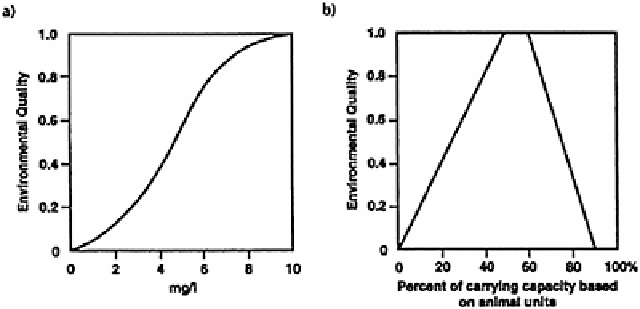Environmental Engineering Reference
In-Depth Information
Figure 4.15
Environmental parameter
functions for the Environmental
Evaluation System: dissolved oxygen
and deer: rangeland ratios: (a)
dissolved oxygen; (b) browsers and
grazers. (
Source
: Dee et al. 1973.)
given an importance weighting, which is then multiplied by the appropriate
environmental quality score. The importance weightings (shown in parentheses in Figure
4.14) are determined by having a panel of experts distribute 1,000 points among the
parameters. For instance, dissolved oxygen is considered quite important, at 31 points out
of 1,000. A composite score for the beneficial and adverse effects of a single project, or
for the net impact of alternative projects, can be obtained by adding up the weighted
impact scores.
As an example of the full use of the EES, assume that the existing deer:rangeland ratio
means that 40 per cent of the annual plant production is consumed (environmental quality
score 0.8 in Figure 4.15). A project likely to halve the deer population would cause the
score to drop to 0.4. The post-development score would be lower than the pre-
development score, so the impact would be negative. This parameter's importance is 14
points out of 1,000, so the pre- and post-development scores would be multiplied by 14,
and could then be compared with other parameters (Dee et al. 1973). Another quantitative
method developed to assess alternative highway proposals (Odum et al. 1975) considers
impact duration: long-term irreversible impacts are considered to be more important than
short-term reversible impacts and are given 10 times more weight. A sensitivity analysis
showed that errors in impact estimation and weighting could significantly affect the
rankings of alternative highway routes. Another method (Stover 1972) considers future
impacts to be more important and gives them higher values than short-term impacts: it
multiplies the numerical rating of each future impact by its duration in years.
The attraction of these quantitative methods lies in their ability to “substantiate”
numerically that a particular course of action is better than others. This may save
decision-makers considerable work, and it ensures consistency in assessment and results.
However, these methods also have some fundamental weaknesses. They effectively take

Search WWH ::

Custom Search